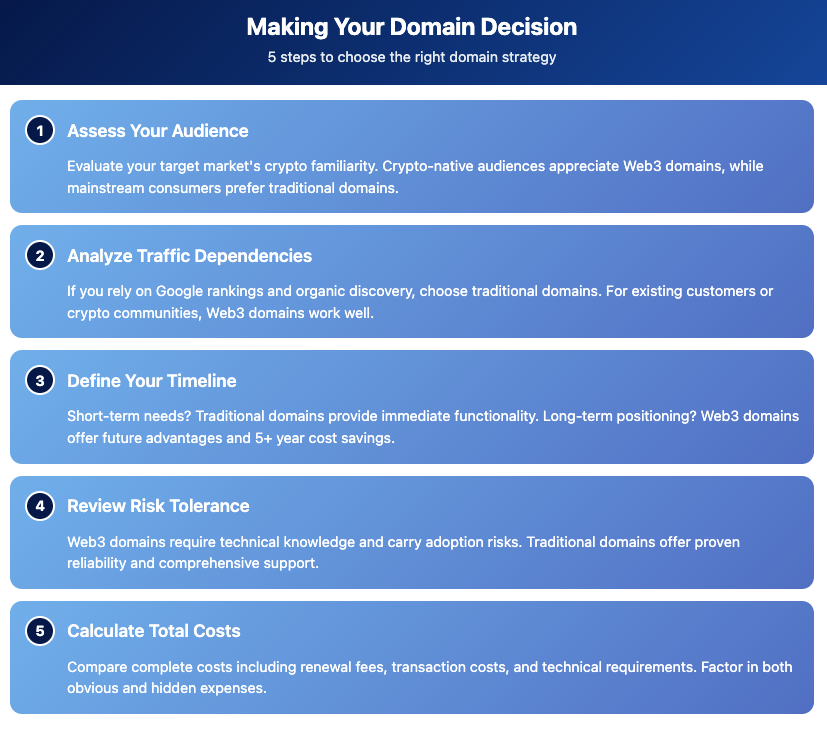Choosing the right domain strategy has never been more complex for businesses navigating today's digital landscape. The domain landscape is evolving rapidly. When Budweiser purchased beer.eth for $95,000 in 2021, it highlighted the growing interest in Web3 domains. Yet most businesses still struggle to understand when blockchain-based domains make practical sense versus traditional options.
This guide provides data-driven analysis to help you choose the right domain strategy based on your business needs, target audience, and long-term goals.
What Is a Web3 Domain?
Web3 domains are blockchain-based domain names stored as NFTs in your cryptocurrency wallet. Unlike traditional domains that you rent annually from registrars, Web3 domains offer true ownership—no central authority can revoke them once you hold the private keys.
These domains operate through smart contracts instead of DNS and are often hosted on decentralized systems like IPFS. Beyond website addresses, they function as multi-purpose digital identities within the blockchain ecosystem, allowing you to send crypto to "john.crypto" instead of complex wallet addresses, create censorship-resistant websites, and serve as universal login credentials across Web3 applications.
The Web3 market was valued at $10.43 billion in 2023 and is expected to grow 34% annually through 2030, though most domains are currently held for speculation rather than active use. The domains themselves become tradeable assets on NFT marketplaces like OpenSea, with some premium names selling for substantial amounts.
Web3 vs Traditional Domains: Key Differences
Understanding the fundamental differences between Web3 and traditional domains is crucial for making informed business decisions. While both serve as digital addresses, their underlying technologies, cost structures, and practical applications differ significantly. Let's examine the key distinctions that impact your domain strategy.
|
Feature |
Traditional Domains |
Web3 Domains |
|
Ownership Model |
Registration (rental) through registrar |
Permanent ownership for some; registration for others |
|
Browser Support |
Universal across all browsers |
Limited to specific browsers |
|
SEO Capability |
Full search engine indexing |
Limited search visibility |
|
Transfer Process |
Transfer codes & registrar approval |
Blockchain transaction |
|
Cost Model |
Annual renewal fees |
One-time purchase (varies by provider) |
|
Technical Complexity |
User-friendly, minimal knowledge required |
Requires crypto and blockchain understanding |
Choosing the Right Domain Type: Strategic Framework
Choose traditional domains when your business requires search engine visibility, serves mainstream audiences, or operates in risk-sensitive environments where predictable costs and customer support are essential. Traditional domains excel for:
-
E-commerce sites that need Google rankings
-
Professional service firms requiring business email
-
Content marketing strategies dependent on organic search
-
Local businesses needing search visibility
-
Risk-averse organizations preferring operational stability
Choose Web3 domains when targeting crypto-native audiences, building blockchain-integrated applications, or pursuing long-term cost optimization for projects spanning a decade or more. Web3 domains make strategic sense for:
-
DeFi protocols and cryptocurrency startups
-
NFT marketplaces and blockchain gaming
-
Decentralized applications requiring censorship resistance
-
Long-term projects benefiting from one-time costs
-
Crypto payment integration and wallet simplification
Use both traditional and Web3 domains in hybrid strategies when pursuing comprehensive brand protection, serving diverse audiences, or hedging against uncertain technological futures. Hybrid approaches work well for:
-
Forward-thinking enterprises entering Web3 space
-
Established brands protecting digital identity
-
Consulting firms demonstrating blockchain expertise
-
Media companies serving both mainstream and crypto audiences
-
Technology companies building cross-platform solutions
Most Expensive ENS Domains Ever Sold
The Ethereum Name Service (ENS) market has established itself as a premium segment of Web3 domains, with record-breaking sales demonstrating the significant value placed on digital identity and blockchain-based naming rights. Here are the five most expensive ENS domains ever sold, showcasing the remarkable appreciation potential in this emerging asset class.
1. paradigm.eth - $2+ Million (420 ETH)
This domain fetched a whopping 420 ETH (over $2 million) in October 2021, making it the current champion. The sale occurred during Ethereum's rally to all-time highs, demonstrating how crypto market cycles can amplify domain values. Interestingly, cryptocurrency firm Paradigm denied any involvement in the purchase, adding mystery to this record-breaking transaction.
2. pjfi.eth - $463,000 (350 ETH)
Sold for 350 ETH (around $463,000) in September 2022, this domain skyrocketed in value after being bought for just $161 on OpenSea days earlier. This represents one of the most dramatic short-term gains in Web3 domain history, highlighting both the speculative nature and potential volatility of the market.
3. 000.eth - $317,000 (300 ETH)
Snagged for 300 ETH (approximately $317,000) in July 2022, this domain has had a colorful history with six owners, with its first sale recorded for just $52 in 2019. The three-digit numerical domain represents the scarcity and appeal of short, memorable ENS names that function well as digital identities.
4. abc.eth - $254,000 (90 ETH)
This classic three-letter domain went for 90 ETH (around $254,000) and has been traded four times since its initial sale for $763 in 2019. The appreciation from $763 to $254,000 demonstrates the long-term value potential of premium three-character domains.
5. wei.eth - $140,000+ (varies)
Following the pattern of premium short domains, wei.eth represents another valuable three-letter combination, with "wei" being a fundamental unit in Ethereum (the smallest denomination of ether), giving it particular significance within the Ethereum ecosystem.
Market Insights and Investment Patterns
These record sales reveal several key patterns that successful Web3 domain investors should understand:
Scarcity Drives Value: Short numerical domains like 000.eth and three-letter combinations like abc.eth consistently command premium prices due to their limited supply. With only 1,000 possible three-digit combinations and 17,576 three-letter combinations, scarcity creates natural investment appeal.
Timing and Market Cycles: The highest sales occurred during crypto bull markets, particularly in 2021-2022, when Ethereum reached all-time highs. This correlation suggests that Web3 domain values are closely tied to broader cryptocurrency market sentiment and adoption cycles.
Utility and Recognition: Domains with inherent meaning within the crypto ecosystem (like wei.eth referencing Ethereum's base unit) or broad appeal (like abc.eth for its simplicity) tend to maintain and appreciate in value more consistently than arbitrary combinations.
The ENS domain market represents a new frontier in digital asset investment, where scarcity, utility, and cultural significance combine to create substantial value appreciation potential for strategic investors who understand the Web3 ecosystem.
Why Web3 Domains Are Worth the Investment
Web3 domains represent a compelling investment opportunity that combines digital real estate fundamentals with emerging technology adoption trends. Here are the key reasons why they're worth considering:
-
Multi-Functional Digital Assets: ENS domains serve as wallet addresses, websites, and tradeable NFTs simultaneously, making a single domain function as your payment address, website, digital identity, and investment asset all at once.
-
Superior Branding Value: Premium domains like "finance.eth" function as marketing powerhouses, providing memorable and brandable digital identities that reinforce recognition across the entire Web3 ecosystem.
-
Cross-Platform Integration: Seamless login functionality across apps, metaverses, and games creates network effects that increase utility over time, benefiting early domain holders without additional investment.
-
True Ownership Benefits: Domains are stored in your cryptocurrency wallet, representing genuine digital asset ownership rather than rental.
The investment case combines scarcity, utility, and growing mainstream adoption in an asset class positioned at the intersection of digital real estate and cryptocurrency market growth.
Investment and Risk Considerations
Web3 domain investment carries unique risks, including technical obsolescence as blockchain protocols may become irrelevant, regulatory uncertainty where future laws could impact ownership rights, and market volatility that fluctuates with cryptocurrency markets. Limited mainstream adoption remains a significant challenge.
However, opportunities exist in this early market with potential for significant appreciation. Increasing utility through growing integration with wallets and applications, expanding corporate interest as more brands explore Web3 presence, and evolving technology with improving browser support create investment potential for informed participants.
Making Your Decision
Follow these five steps to determine the right domain strategy for your business:

Recommended Strategies:
-
Most Businesses: Start with traditional domains for primary operations while considering Web3 domains for brand protection or specific blockchain use cases. Monitor technology development for future opportunities.
-
Crypto-Focused Companies: Prioritize Web3 domains for core functionality while maintaining traditional domains for mainstream accessibility and regulatory compliance.
Conclusion
The choice between traditional and Web3 domains should align with your specific business needs rather than industry trends. Traditional domains remain the gold standard for businesses requiring search visibility and universal accessibility, while Web3 domains excel for crypto-native applications and long-term cost optimization.
Most successful strategies involve a hybrid approach: using traditional domains for mainstream business operations while exploring Web3 domains for specific blockchain applications or future positioning. Evaluate your audience, timeline, and technical requirements to make informed decisions that support your business goals as the domain landscape continues evolving.
